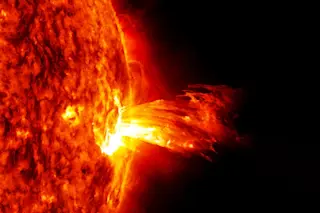The sky’s most famous star? No contest: It’s Polaris, the North Star. And as with most celebrities, misconceptions surround it. People often assume, for example, that it’s a brilliant star. But Polaris is only about fiftieth on the sky’s list of luminaries--capable of appearing over light-polluted cities but never brilliant enough to really stand out. Polaris may be amazing, but brightness is not its métier. Its uniqueness becomes clear only after Earth’s rotation has whirled the sky around, with most of the stars arcing in their grand and endless ballet. But not Polaris. Our axis of spin points, by chance, in its direction, causing Polaris to appear glued in place. I am constant as the northern star, says Shakespeare’s Julius Caesar, longing perhaps to link to it his own dreams of immortality.
It’s an improbable coincidence, this conspicuous distant sun sitting within a single degree of the celestial pole, the ...














